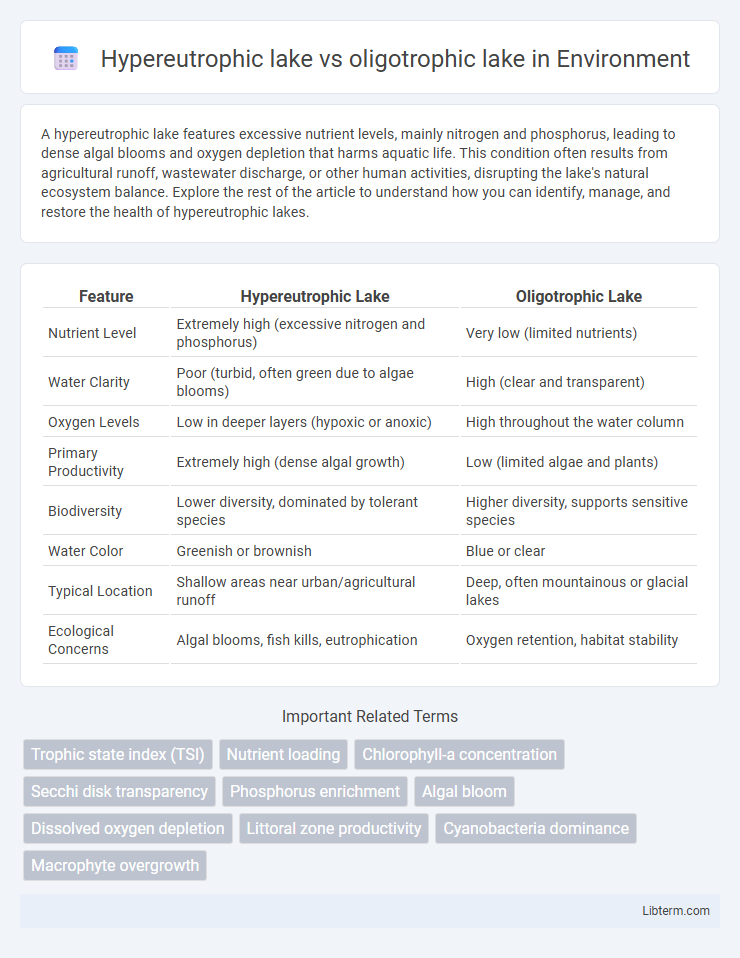A hypereutrophic lake features excessive nutrient levels, mainly nitrogen and phosphorus, leading to dense algal blooms and oxygen depletion that harms aquatic life. This condition often results from agricultural runoff, wastewater discharge, or other human activities, disrupting the lake's natural ecosystem balance. Explore the rest of the article to understand how you can identify, manage, and restore the health of hypereutrophic lakes.
Table of Comparison
| Feature | Hypereutrophic Lake | Oligotrophic Lake |
|---|---|---|
| Nutrient Level | Extremely high (excessive nitrogen and phosphorus) | Very low (limited nutrients) |
| Water Clarity | Poor (turbid, often green due to algae blooms) | High (clear and transparent) |
| Oxygen Levels | Low in deeper layers (hypoxic or anoxic) | High throughout the water column |
| Primary Productivity | Extremely high (dense algal growth) | Low (limited algae and plants) |
| Biodiversity | Lower diversity, dominated by tolerant species | Higher diversity, supports sensitive species |
| Water Color | Greenish or brownish | Blue or clear |
| Typical Location | Shallow areas near urban/agricultural runoff | Deep, often mountainous or glacial lakes |
| Ecological Concerns | Algal blooms, fish kills, eutrophication | Oxygen retention, habitat stability |
Definition of Hypereutrophic and Oligotrophic Lakes
Hypereutrophic lakes are characterized by extremely high nutrient concentrations, particularly phosphorus and nitrogen, leading to excessive algae growth and reduced oxygen levels, which often results in poor water quality and decreased aquatic biodiversity. Oligotrophic lakes contain low nutrient levels, clear water, and high oxygen content, supporting diverse and healthy aquatic ecosystems with limited algae growth. These contrasting nutrient conditions significantly influence lake ecology, water clarity, and the overall health of freshwater habitats.
Key Differences in Water Quality
Hypereutrophic lakes exhibit extremely high nutrient levels, leading to excessive algae blooms and severely reduced oxygen concentrations, often causing fish kills and poor water clarity. In contrast, oligotrophic lakes have low nutrient concentrations, resulting in clear water, high dissolved oxygen throughout the water column, and minimal algal growth. The key water quality differences lie in nutrient content, oxygen availability, and water transparency, which significantly impact aquatic ecosystems and recreational usability.
Nutrient Levels and Sources
Hypereutrophic lakes exhibit extremely high nutrient levels, primarily from excessive inputs of nitrogen and phosphorus due to agricultural runoff, wastewater discharge, and urban stormwater, leading to dense algal blooms and oxygen depletion. In contrast, oligotrophic lakes have low nutrient concentrations, sourced mainly from limited weathering of surrounding rocks and minimal external nutrient loading, resulting in clear water and high oxygen content. The stark difference in nutrient availability directly influences the aquatic ecosystem structure, water quality, and biological productivity in each lake type.
Ecological Consequences
Hypereutrophic lakes exhibit excessive nutrient enrichment, leading to dense algal blooms that reduce oxygen levels and disrupt aquatic life, often causing fish kills and loss of biodiversity. In contrast, oligotrophic lakes maintain low nutrient concentrations, supporting clearer waters, higher oxygen content, and diverse, stable ecosystems with thriving fish populations. The ecological imbalance in hypereutrophic lakes results in habitat degradation, while oligotrophic lakes provide optimal conditions for native species and aquatic health.
Dominant Plant and Algae Species
Hypereutrophic lakes are dominated by dense populations of cyanobacteria (blue-green algae) such as Microcystis and Anabaena, alongside abundant macrophytes like Water Hyacinth and Duckweed, which thrive in nutrient-rich environments. In contrast, oligotrophic lakes support sparse algal communities primarily composed of diatoms and green algae, with submerged aquatic plants like Isoetes and Elodea adapted to low-nutrient, clear-water conditions. The disparity in nutrient levels directly influences the composition and abundance of dominant plant and algae species, impacting the lake's overall ecosystem dynamics.
Wildlife and Biodiversity Comparison
Hypereutrophic lakes exhibit low biodiversity with dominance by algae and few fish species adapted to low oxygen levels, often causing fish kills and reduced aquatic wildlife diversity. Oligotrophic lakes support diverse wildlife, including various fish species, aquatic plants, and invertebrates, due to high oxygen levels and clear water. The rich biodiversity in oligotrophic lakes contrasts sharply with the limited and stressed ecosystems found in hypereutrophic lakes.
Human Impact and Land Use Influence
Hypereutrophic lakes exhibit excessive nutrient enrichment primarily from agricultural runoff and urban wastewater, leading to harmful algal blooms and oxygen depletion that severely degrade aquatic ecosystems. In contrast, oligotrophic lakes have low nutrient levels, often found in less disturbed catchments with minimal human activity and well-managed land use, preserving their clear water and high oxygen content. Land use practices such as deforestation, agriculture, and urbanization disproportionately impact hypereutrophic lakes by accelerating nutrient loading, while oligotrophic lakes remain more resilient due to limited anthropogenic disturbances.
Water Clarity and Color Variations
Hypereutrophic lakes exhibit low water clarity due to excessive nutrient levels fueling dense algal blooms, which often result in green or brownish water color variations. In contrast, oligotrophic lakes maintain high water clarity with minimal algae growth, showcasing clear blue or greenish hues. These differences in water clarity and color are primarily driven by nutrient concentrations and biological activity within each lake type.
Recreational Uses and Limitations
Hypereutrophic lakes, characterized by excessive nutrient levels and dense algal blooms, often face severe oxygen depletion, limiting swimming, boating, and fishing activities due to poor water quality and unpleasant odors. In contrast, oligotrophic lakes have low nutrient concentrations, clear water, and high dissolved oxygen, making them ideal for recreational uses such as swimming, scuba diving, and sport fishing. The ecological health of oligotrophic lakes supports diverse fish populations and enhances aesthetic appeal, whereas hypereutrophic conditions frequently result in reduced biodiversity and restricted recreational access.
Conservation and Restoration Strategies
Hypereutrophic lakes demand aggressive conservation strategies such as nutrient load reduction through improved agricultural practices and wastewater treatment to prevent harmful algal blooms and oxygen depletion. Oligotrophic lakes require preservation efforts focused on protecting watershed integrity and minimizing pollutant inputs to maintain their high water quality and biodiversity. Restoration techniques for hypereutrophic lakes often involve sediment dredging, aeration, and biomanipulation, whereas oligotrophic lakes benefit from strict land-use controls and ongoing water quality monitoring.
Hypereutrophic lake Infographic

 libterm.com
libterm.com